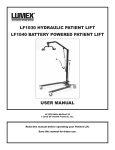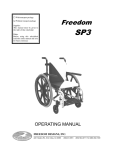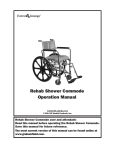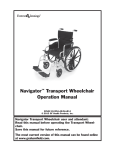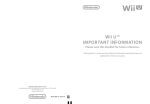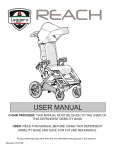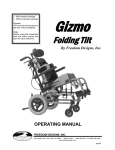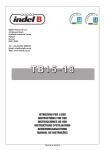Download Recliner - Medicaleshop.com
Transcript
Recliner
Manual Wheelchair
User Manual
CONTENTS
1 INTRODUCTION.........................................................................3
2 IMPORTANTSAFETYPRECAUTIONS........................................5
3 GETTINGSTARTED...................................................................8
4 HANDLINGTIPS......................................................................10
5 ADJUSTMENTS.......................................................................14
6 MAINTENANCE.......................................................................22
7 TROUBLESHOOTING...............................................................28
8 LIMITEDWARRANTY..............................................................29
9 INDEX.....................................................................................31
2
3K01-INS-LAB-RevB13•AdvantageReclinerUserManual
READTHISMANUALBEFOREOPERATINGYOURWHEELCHAIR
1 INTRODUCTION
Important safety, operating, and maintenance instructions that warrant
your attention are included in this user manual. Read the entire manual
carefully before operating your new wheelchair, and refer to it as often as
necessary to help maintain good performance standards.
Consult your healthcare professional and GF Health Products, Inc.
("Graham-Field") authorized distributor for assistance in developing and
learning safe and effective techniques for performing your daily activities
according to your individual physical abilities and needs, and to make certain
that your wheelchair is properly prescribed and adjusted for your use.
The safety precautions in this manual are general warnings intended
to be used only as basic guidelines. You may ind it necessary to
develop your own methods for safely solving frequently encountered
challenges. Again, consult your professional medical advisors for their
recommendations about safety methods, and never hesitate to ask for
their assistance.
Your wheelchair should receive frequent, regularly scheduled
maintenance, including an inspection of the mechanical parts, to
ensure proper operation. Some suggested inspection procedures,
troubleshooting procedures, and adjustment procedures are included in
this manual. When it comes to service and repair, remember that your
Graham-Field authorized distributor knows your wheelchair best.
Thank you for choosing an Everest & Jennings product. We at
Graham-Field wish to assure you of our continuing commitment to
provide innovation and quality in our products. The Advantage Recliner
is a manual, folding, lightweight wheelchair, suitable for frequent users
who require a lightweight, portable wheelchair, itted to their anatomy,
without the need of customization or alteration to the center of gravity.
The Advantage Recliner is intended for indoor and / or outdoor use. The
Advantage Recliner comes with a higher back and removable full support
headrest which includes an additional neck support that adjusts easily to
it every need. Anti-tippers and an anti-fold bar are standard.
3K01-INS-LAB-RevB13•AdvantageReclinerUserManual
3
The person performing adjustments on the Advantage Recliner has the
responsibility of making certain that the user can safely operate the
wheelchair with the adjustments selected. This person must evaluate the
user's ability, weight, physical condition, the environment in which the
wheelchair will be used, and the terrain over which the wheelchair will
travel. We recommend the use of anti-tippers at all times.
WARNING: Anti-tippers must be installed in the downward
position.
Please note the following special statements, used throughout this
manual, and their signiicance:
WARNING: Indicates a potential hazard situation or unsafe
practice that, if not avoided, could result in death or serious
personal injury.
CAUTION: Indicates a potential hazard situation or unsafe
practice that, if not avoided, could result in minor or moderate
personal injury.
s NOTICE: Indicates a potential hazard situation or unsafe
practice that, if not avoided, could result in product or property
damage.
Info: Provides application recommendations or other useful
information to ensure that you get the most from your product.
4
3K01-INS-LAB-RevB13•AdvantageReclinerUserManual
2 IMPORTANTSAFETYPRECAUTIONS
IMPORTANTSAFETYPRECAUTIONS:ALWAYSFOLLOWTHESESAFETY
PRECAUTIONSWHENUSINGYOURWHEELCHAIR.FAILURETODO
SOCOULDRESULTINPERSONALINJURYTOYOUOROTHERSOR
DAMAGETOYOURWHEELCHAIR.
Safety requires the constant attention of the wheelchair user and the
attendant. It is extremely important to learn and always use safe methods
of performing basic daily activities. Always consult your healthcare
professional to determine those methods most suitable for your
individual abilities.
Protect yourself and your wheelchair by having your Advantage Recliner
serviced regularly. Whenever any part of your Advantage Recliner is not
functioning properly, contact your Graham-Field authorized distributor
immediately, as a hazardous situation could result, causing personal
injury or damage to your wheelchair. ONLY EXCELLENT CONDITION
IS ACCEPTABLE WHERE SAFETY IS CONCERNED. Periodic
inspection, adjustment, and replacement of worn parts will provide many
years of superb performance.
WARNINGS
WARNING: Advantage Recliner maximum weight capacity is
300 lb (136 kg), EVENLY DISTRIBUTED.
WARNING: Do not operate this wheelchair on streets or
roadways.
WARNING: Do not operate this wheelchair on hilly or rough
terrain, sand, wet or icy surfaces, or surfaces with impaired
traction. Ensure that pathway is clear of all obstacles.
WARNING: Do not turn wheelchair while going downhill, as
wheelchair could tip over.
WARNING: Do not attempt inclines without anti-tippers installed
in the downward position. Do not attempt any incline or decline
greater than six degrees (10% grade, or one foot of rise or fall
per ten feet of ramp length).
3K01-INS-LAB-RevB13•AdvantageReclinerUserManual
5
WARNING: This wheelchair does not offer seating or occupant
restraint equivalent to the seat provided in a motor vehicle! To
increase your safety while traveling in a motor vehicle, always
transfer to the vehicle seat and use the restraint provided by
the vehicle manufacturer.
WARNING: Do not tie down or attach anything to the wheels.
This could cause tipping and possibly result in injury or damage
to the wheelchair.
WARNING: The footplates' lowest point should clear the ground
by at least 2 1/2 inches, to permit proper clearance of potential
obstruction.
WARNING: Doing a "wheelie" (tilting the wheelchair backward
until it reaches its balance point) is dangerous and could result
in personal injury to the user.
WARNING: Do not stand or step on the footplates while
transferring to or from your wheelchair. This could cause the
wheelchair to tip or may cause personal injury or damage to
your wheelchair.
WARNING: Do not place your hands between seat rail and side
panel.
WARNING: Always engage wheel locks before transferring,
using a wheelchair lift or using an elevator.
WARNING: Ensure that wheelchair is on a stable, level surface
and engage wheel locks before and during transfer.
WARNING: Operate only with anti-tippers in place when leaning
or tipping. When in use, anti-tippers must be installed in the
downward position.
WARNING: Do not lean over the top of the wheelchair back. This
could cause the wheelchair to tip over.
WARNING: To reduce the risk of tipping before leaning or
reaching forward, sit back in the seat and rotate casters fully
toward front of wheelchair.
WARNING: Unauthorized modiication or the use of
non-Everest & Jennings replacement parts could change the
structure of the wheelchair, void the warranty, and create a
hazardous condition resulting in serious personal injury.
6
3K01-INS-LAB-RevB13•AdvantageReclinerUserManual
WARNING: Do not lean on this wheelchair or use it as a
walker—these are practices which could result in loss of
balance and personal injury.
WARNING: Do not use your wheelchair on escalators.
WARNING: Wheel locks are not brakes. Do not use the wheel
locks to slow down your wheelchair, or while the wheelchair is
moving. Wheel locks are only intended to keep the wheelchair
in place when it is at a complete stop.
WARNING: Notice for California Customers- California
Proposition 65 WARNING: This product contains a chemical
known to the State of California to cause cancer and
reproductive or developmental harm.
WARNING: GF Health Products, Inc. speciically disclaims
responsibility for any personal injury or property damage which
may occur during any use which does not comply with federal,
state, or local laws or ordinances.
3K01-INS-LAB-RevB13•AdvantageReclinerUserManual
7
3 GETTINGSTARTED
Please familiarize yourself with main components, identiied in
Advantage Recliner illustration below.
headrest
back upholstery
handgrip
armpad
trigger release
arm
anti-fold bar
seat upholstery
backpost
elevating
legrest
mech lock
leg pad
handrim
anti-tipper
rear wheel
footrest
frame
caster socket
wheel lock
caster fork
caster wheel
crossbrace
Advantage Recliner
8
3K01-INS-LAB-RevB13•AdvantageReclinerUserManual
OPERATIONOFRECLINER
LOWERINGANDRAISINGRECLININGBACK
WARNING: If you are lowering or raising the reclining back while
the user is seated in the Advantage Recliner, take care not to
let the back drop. This could cause serious personal injury.
WARNING: Do not operate wheelchair unless seat back is in a
fully upright position.
WARNING: Ensure reclining back is locked in place before
occupying or operating wheelchair.
removable headrest
back
upper end
of backpost
handgrip
trigger release
lowering and raising reclining back
LoweringRecliningBack
Pull the trigger releases located below the push handles on both sides
simultaneously and recline the back to desired incremental position. Lock
into place by releasing trigger releases.
RaisingRecliningBack
Pull the trigger releases located below the push handles on both sides
simultaneously and recline the back to desired incremental position. Lock
into place by releasing trigger releases.
REMOVABLEHEADREST
InstallationofRemovableHeadrest
To install the removable headrest, insert the headrest posts into the
upper ends of the backposts as shown above.
3K01-INS-LAB-RevB13•AdvantageReclinerUserManual
9
4 HANDLINGTIPS
The Everest & Jennings Advantage Recliner has been designed and
engineered to perform as a stable and well balanced unit when used for
its intended purpose. However, it is possible to tip the Advantage Recliner
over if it is used improperly. We urge you to learn the characteristics
of your wheelchair. It is most important to learn safe methods to
perform the daily activities basic to your lifestyle. Consult your medical
professionals for assistance in developing the skills and proper
techniques to perform all activities safely.
BALANCE
Proper balance is the key to maintaining the stability of your wheelchair.
Reaching, bending, and transferring to or from a wheelchair will change
the weight distribution and center of gravity of you and your wheelchair.
When performing such activities, do so as instructed in the following
paragraphs to avoid tipping the wheelchair.
TRANSFERACTIVITIES
WARNING: Always ensure that the wheelchair is on a stable,
level surface and engage wheel locks before transfer.
WARNING: Do not step on the footplates; this could cause the
wheelchair to tip. Fold them up, and either detach them, or
swing them aside.
WARNING: There is a critical moment when there is little or no
seat platform beneath you. Take every precaution to reduce this
unsupported distance before you attempt transfer.
Transferring into or out of a wheelchair is a very dificult maneuver.
Exercise extreme care when transferring without the aid of either an
attendant or a patient lift. Consult your physician, nurse, or physical
therapist for assistance in developing your individual technique. Make
sure that the wheelchair is stabilized, and will not move or slide during
the transfer. Take extra precaution to prevent tipping. Use good body
mechanics to prevent personal injury.
10
3K01-INS-LAB-RevB13•AdvantageReclinerUserManual
REACHING/BENDING
WARNING: Always turn the casters frontward to provide
stability while reaching. If in doubt, ask for assistance or use a
device that will extend your reach without requiring you to shift
your weight.
Although it is not recommended, you may ind it occasionally necessary
to lean or reach from your wheelchair. Consult with your healthcare
professional for assistance in developing your personal safe reaching or
moving techniques suited to your ability and restrictions.
Forwardorsideward
WARNING: Do not attempt to reach objects if you are required
to move forward in the seat. Do not attempt to retrieve objects
from the loor if you must reach down between your knees.
Do not shift your weight in the direction that you are reaching
and / or bending; this could cause the wheelchair to tip.
1. Maneuver the wheelchair as close as possible to the object you wish
to reach.
2. Rotate both casters fully forward, go forward, and then back the
wheelchair toward the object to swing the casters fully forward.
3. Engage both wheel locks.
4. Ensure the casters are rotated fully forward before reaching. If not,
repeat step 2.
Backward
WARNING: Do not engage the wheel locks while reaching
or bending backward. Should your weight suddenly shift
accidentally, it is better to roll in that direction than to tip over.
WARNING: Do not lean over the back upholstery; this could
cause the wheelchair to tip.
1. Maneuver the wheelchair as close as possible to the object; the rear
wheels will limit how close you can get.
2. Rotate both casters fully forward, go forward, and then back the
wheelchair toward the object to swing the casters fully forward.
3. Reach only as far as your arm will extend without changing your sitting
position. If in doubt, reposition the wheelchair or ask for assistance.
3K01-INS-LAB-RevB13•AdvantageReclinerUserManual
11
RAMPSANDINCLINES
WARNING: During descent, the footplates' lowest point should
be no closer to the ground than 2 1/2 inches to permit proper
clearance.
WARNING: Do not attempt inclines without anti-tippers installed
in the downward position. Do not attempt any incline or decline
of more than 6 degrees (10% grade, or one foot of rise or fall
per ten feet of ramp length).
WARNING: Do not use wheel locks to slow your descent.
Attempting to use wheel locks is likely to result in accidental
locking that could cause the wheelchair to stop abruptly,
suddenly pitch forward, or tip sideways.
WARNING: Avoid changing direction while descending a ramp or
incline, as this could cause instability.
Most people are capable of negotiating short inclines without assistance,
depending upon upper body strength, endurance, and the degree of
incline. Know your own capabilities and limitations in terms of strength
and endurance before attempting to negotiate an incline or decline.
Practice with an attendant or healthcare professional irst before
attempting any inclines, declines, curbs or ramps. Always inspect the
ramp for hazards such as holes, slippery or uneven surfaces, etc. before
starting up or down. If you can not see the entire ramp, ask someone to
inspect it for you.
Ascent
Lean the upper part of your body slightly forward as you ascend the
incline. If it becomes necessary to stop on the incline, avoid any abrupt
or sudden forward movement as you resume climbing, this could cause
tipping.
Descent
Always face forward when going down a ramp, but do not lean forward;
this could cause tipping. Lean slightly backward to increase stability. It is
critical to keep the wheelchair under control at all times. Descent should
be made slowly and safely by grasping the handrims; however, use care,
as friction heat will be generated. We recommend the use of gloves to
reduce the effects of friction heat, but going slower is a better alternative.
12
3K01-INS-LAB-RevB13•AdvantageReclinerUserManual
CURBSANDSTEPS
Curbs, steps and stairways are dangerous obstacles that confront the
wheelchair user. When you encounter curbs, ind a way around, or use
the ramps now available in most locations. If you encounter steps and
there is no ramp available, avoid the steps by utilizing the disabled
designated elevators now required in most locations.
WARNING: Never attempt to negotiate steps, stairs or
escalators in your Advantage Recliner.
3K01-INS-LAB-RevB13•AdvantageReclinerUserManual
13
5 ADJUSTMENTS
The Advantage Recliner offers several adjustments to make it easier
and more comfortable to drive. Section 6, MAINTENANCE, offers
preventive maintenance suggestions for keeping your wheelchair
in excellent condition; ensure that all components are in excellent
condition before adjusting. The following are recommended methods;
after a few adjustments, you may develop your own. Always consult your
Graham-Field authorized distributor for assistance.
The person performing adjustments on the Advantage Recliner has the
responsibility of making certain that the user can safely operate the
wheelchair with the adjustments selected. This person must evaluate the
user's ability, weight, physical condition, the environment in which the
wheelchair will be used, and the terrain over which the wheelchair will
travel.
All adjustments and their page locations are referenced in the index at
the end of this manual. Speciic tools needed to perform each adjustment
are identiied in adjustment directions. A complete list of tools needed to
perform all adjustments in this section follows:
Hex wrench furnished with wheelchair
M13 wrench
M10 wrench
M5 hex key
14
3K01-INS-LAB-RevB13•AdvantageReclinerUserManual
REARWHEELS&CASTERS
We recommend that you do not replace or adjust rear wheel or caster
components yourself, since special tools and training are required. Please
contact your Graham-Field authorized distributor when your rear wheels
or casters need adjustment, or if you wish to change seat height.
3K01-INS-LAB-RevB13•AdvantageReclinerUserManual
15
ARMS
Info: Fixed arms are not removable. Only detachable
Advantage Recliner arms, as shown below, are removable.
Removearm
1. Depress arm release
pin until it unlocks.
right arm
2. Hold arm by center of
armpad. Lift straight
up and off.
Installarm
Hold arm by center of
armpad. Lower arm
straight down into sockets
and push to lock. Ensure
that release pin is locked
in place.
release pin
front arm socket
remove arm
WARNING: Ensure arm release is locked in place before
occupying or operating wheelchair.
16
3K01-INS-LAB-RevB13•AdvantageReclinerUserManual
FRONTRIGGING
ELEVATINGLEGREST—DETACHABLE,SWINGAWAY
WARNING: The footplates' lowest point should be no closer to
the ground than 2 1/2 inches, to permit proper clearance.
WARNING: Do not stand on the footplates; this could cause the
wheelchair to tip.
Removeelevatinglegrest
1. To release lock, pull
hinge
swingaway release
plate
lever forward, toward
front of wheelchair.
Legrest will swing
swingaway
outward.
release lever
2. To remove, lift
legrest straight up
off wheelchair hinge
pins.
Attachelevatinglegrest
1. Set legrest on
wheelchair (so that
legrest hinge plates
engage wheelchair
hinge pins).
2. Swing legrest
inward.
remove elevating legrest
3. Ensure legrest is
locked in place and swingaway release lever is locked in a rearward
position, toward back of wheelchair.
WARNING: Ensure legrests are locked in place before occupying
or operating wheelchair.
3K01-INS-LAB-RevB13•AdvantageReclinerUserManual
17
ADJUSTLEGRESTELEVATION
CAUTION: It is possible to RAISE the elevating legrest without
moving the legrest release lever. As a safety feature, however,
in order to LOWER the elevating legrest you must move the
legrest release lever. This is to prevent the legrest from
accidentally dropping while the user's leg is elevated.
WARNING: Ensure elevating legrests are locked in place before
occupying or operating wheelchair.
Raiseelevatinglegrest
Slowly rotate the legrest up to
the desired position. Ensure
elevating legrest is locked in
position.
legrest
release lever
Lowerelevatinglegrest
1. To allow the elevating
legrest to lower without
dropping suddenly, support
its weight and move the
release lever forward.
2. Slowly lower elevating
legrest to desired position.
3. Release lever. Ensure
elevating legrest is locked
in position before letting go
of legrest.
legrest
panel
adjust legrest
Adjustelevatinglegrestpanelposition
The legrest panel can be rotated up and out of the way. Refer to picture
above.
1. To adjust panel, hold the panel and rotate it upward.
2. To return panel to position, hold the panel and rotate downward.
The panel will stop at the proper position.
WARNING: Ensure legrest panels are locked in place before
occupying or operating wheelchair.
18
3K01-INS-LAB-RevB13•AdvantageReclinerUserManual
Adjustlegrestfootplateextensionlength
1. See picture at right.
Loosen latch to free
footplate extension
inside legrest hanger.
2. Press down on the
locking button and
adjust the footplate
to the desired length.
Ensure the locking
button is completely
extended and
securely fastened in
the adjustment hole.
3. Fasten latch to secure
footplate extension
inside legrest hanger.
hanger
locking
button
adjustment
holes
latch
footplate
4. Repeat steps 1-3 for
the other footplate
extension.
elevating legrest
footplate extension,
adjust length
5. Ensure both footplate
extensions are securely fastened and that minimum ground
clearance is 2 1/2 inches.
WARNING: Ensure that footplates are securely fastened before
occupying or operating wheelchair.
3K01-INS-LAB-RevB13•AdvantageReclinerUserManual
19
CROSSBRACES
Tightencrossbraces
M13 wrench, M5 hex key
Check the crossbraces to ensure that the bolt and nut securing both
crossbraces in the center of the wheelchair are secure (crossbraces
should be loose enough to fold easily, yet snug enough to take up excess
play). Use an M13 wrench and M5 hex key to tighten.
20
3K01-INS-LAB-RevB13•AdvantageReclinerUserManual
WHEELLOCKS
Adjustwheellocks
M10 wrench
right rear wheel 1. Use an M10 wrench to
loosen the adjustment
bolt until the wheel lock
slides on the frame.
wheel lock
adjustment bolt
right front frame
2. Place the wheel lock in
the locked position and
slide it into contact with
the tire.
3. Place the wheel lock in
the unlocked position
and slide it 3/8" closer to
the tire.
wheel lock
shown unlocked
4. Use an M10 wrench to
tighten the adjustment bolt and engage the wheel lock to check the
it. The wheel lock should indent the tire at least 3/8".
5. Repeat steps 1-4 for other wheel lock. Tighten the adjustment bolts
securely to eliminate wheel lock movement on frame.
WARNING: Ensure that wheel locks are adjusted so that they
lock in place appropriately before occupying or operating
wheelchair.
3K01-INS-LAB-RevB13•AdvantageReclinerUserManual
21
6 MAINTENANCE
Protect your E&J Advantage Recliner by having it serviced regularly.
Proper care and maintenance are essential to keep your wheelchair in
safe working condition. Periodic inspection, adjustment, and replacement
of worn parts will provide many years of superb performance. When
you believe that a component or part of your Advantage Recliner is not
functioning properly, contact your Graham-Field authorized distributor
immediately, as a potentially hazardous condition could result. Only
excellent condition is acceptable where safety is concerned.
Servicemanual
There is no service manual for the Advantage Recliner. Please contact
your Graham-Field authorized distributor with service questions not
answered by this manual.
Info: We recommend that you have a Graham-Field authorized
distributor perform a six month maintenance check, as the
distributor may ind and correct a problem which might
otherwise go undetected and eventually cause more serious
problems and / or personal injury.
22
3K01-INS-LAB-RevB13•AdvantageReclinerUserManual
Do-it-yourselfmaintenance
You can do many of the scheduled maintenance tasks yourself, if you
have mechanical ability and a few basic tools. Refer to the maintenance
schedule below for the recommended regularity of each procedure. If
any maintenance procedure is not clear to you, ask your Graham-Field
authorized distributor for assistance.
s NOTICE: Improper maintenance can cause operating problems
and may affect your warranty.
WARNING: Unauthorized modiication or the use of
non-Everest & Jennings replacement parts could change the
structure of the wheelchair, void the warranty, and create a
hazardous condition resulting in serious personal injury.
MAINTENANCE SCHEDULE
Procedure
Check tire wear
Check handrims
Check wheel lock engagement
Check anti-tippers (optional)
Wipe off frame with soft cloth
Check handgrips
Check upholstery
Check rear wheel adjustment
Check arms
Check backposts / push handles
Check footrests / elevating legrests
Clean frame
Check caster stem rotation
GF distributor maintenance check
Check rear wheel bearings (distributor)
Check caster bearings (distributor)
Perform at least every
Week Month 3 Months 6 Months
✔
✔
✔
✔
✔
✔
✔
✔
✔
✔
✔
✔
✔
✔
✔
✔
3K01-INS-LAB-RevB13•AdvantageReclinerUserManual
23
Listoftools
The tools and cleaning supplies listed will assist in the procedures
outlined in Section 6.
30 weight oil (available at most auto parts stores)
Phillips screwdriver
soft cloth
mild soap and water solution
Generalcare
Always evaluate the overall operation of your wheelchair. It should
function with ease and should travel straight without excessive drag or
pull to one side.
Remember, your Graham-Field authorized distributor knows your
wheelchair best when it comes to service and repairs. Contact your
distributor with any questions or concerns regarding the safe operation
and maintenance of your wheelchair. Regular maintenance is essential
for your safety and continued operation of your wheelchair.
Checktirewear
Examine tires at least once a week for surface wear and cracks and
replace them as needed. Replace tires when they become loose on the
rims or cracks appear.
Checkhandrims
Check handrims at least once a week. Inspect each handrim for rough or
sharp edges and, if any are found, replace handrims immediately. Ensure
that all hardware is properly aligned and secure.
24
3K01-INS-LAB-RevB13•AdvantageReclinerUserManual
Checkwheellockengagement
Check wheel lock engagement at least once a week. See Adjust wheel
locks in Section 5 to adjust wheel lock engagement. If a wheel lock
is worn or damaged, replace it immediately. Inspect the hardware for
looseness or signs of wear.
Ensure that the locking mechanism operates smoothly. The locking
assembly should be tight enough so that the wheel can not rotate or the
lock slip. Check that the locking shoe does not press against the tire
when in the unlocked position. Excessive force should not be required to
either engage or release wheel locks. Oil the wheel lock pivot points with
one or two drops of 30 weight oil. Remove excess oil and dirt.
Checkanti-tippers
Check the anti-tippers at least once a week. Ensure the anti-tippers are
securely fastened and properly positioned.
WARNING: Anti-tippers must be installed in the downward
position.
Checkhandgrips
Check handgrips at least once a week. Ensure that they are not ripped;
ensure that they are tight and securely fastened.
Checkupholstery
Check upholstery at least once a month. Inspect for rips, tears and
worn spots. Ensure that all upholstery-attaching screws are present,
properly aligned, and well-secured. Use a Phillips screwdriver to tighten
upholstery mounting screws. Check attaching screws for sharp edges or
stripped screws, and replace if found.
WARNING: Worn or torn upholstery, or upholstery with loose
hardware, must be replaced immediately. It may not support
body weight.
3K01-INS-LAB-RevB13•AdvantageReclinerUserManual
25
Checkrearwheeladjustment
Inspect the wheels at least once a month. Check alignment by elevating
the rear of the wheelchair on a stable object until the rear wheels clear
the ground, or placing the wheelchair upside down in a stable position
such that the wheels can spin freely. Spin the wheels; there should be no
wobble or sideplay, and the wheels should spin freely without binding.
The bearings should be clean and rotate smoothly. Check rim sideplay
to verify that bearings are not too loose. If there is a problem, contact
your Graham-Field authorized distributor. If adjustment is required, this
should be done by your Graham-Field authorized distributor only.
Checkarms
Check arms at least once a month. Inspect for sharp edges or cracks
which could weaken the arm, and replace if found. Ensure all attaching
screws are present and tight. Use a Phillips screwdriver to tighten arm
pad mounting screws. Check for burrs on the screw heads and replace if
found. Ensure that screws do not extend into the padding. Conirm that
the posts at base of arm it correctly in the sockets, snug but not binding.
Checkbackposts/pushhandles
Check backposts at least once a month. Ensure all mounting hardware
is securely fastened and the backposts are not bent or damaged. Contact
your authorized distributor if you observe cracking or peeling paint or
plating.
Checkelevatinglegrests
Check elevating legrests at least once a month. Inspect the locking
mechanisms to conirm sure it. Check for cracks, burrs, or sharp edges,
and replace if found. Ensure that the legrest will automatically lock
securely in place and will not accidentally unlock.
26
3K01-INS-LAB-RevB13•AdvantageReclinerUserManual
CleaningyourAdvantageRecliner
Wipe off the frame frequently, at least once a week, using a soft cloth.
Dry the wheelchair immediately if exposed to moisture. Clean the frame
every three months with a mild soap and water solution. The frame
does not need to be waxed. Do not use solvents, abrasive waxes, caustic
chemicals or spray silicone. Never use abrasive cleansers; they could
scratch the inish. Never use steam or high pressure cleaners. Clean
upholstery and plastic components at least once a month with a mild soap
and water solution.
Checkcasters
Check the caster stems for proper rotation at least every three months.
The caster forks must swivel freely to facilitate steering and handling.
Adjusting the stem nut varies the amount of force required to turn the
caster. If the stem nut is too loose, the caster will lutter or shimmy; if
too tight, the wheelchair will be dificult to steer. If the caster stems
require adjustment, or the stem bearings require replacement, contact
your Graham-Field authorized distributor. Ensure that stems are irmly
attached to forks, and that forks and stems are not bent. Evaluate all
threads, locking nuts and bearings.
Checkwheelbearings
Have your Graham-Field authorized distributor check caster and rear
wheel axle bearings at least every six months.
3K01-INS-LAB-RevB13•AdvantageReclinerUserManual
27
7 TROUBLESHOOTING
Continual use of your Advantage Recliner necessitates maintenance,
especially if the factory-set adjustments have been altered. The following
troubleshooting guide lists several common problems that may occur,
and offers corrective actions for each. If you are unsure of the solution or
unable to diagnose the problem, do not hesitate to ask your Graham-Field
authorized distributor for assistance.
chair veers right
sluggish turning
chair veers left
caster flutter
squeaks / rattles
looseness in wheelchair
SYMPTOM
PROBABLE CAUSE AND
CORRECTIVE ACTION
Nuts and / or bolts may be loose. If so, tighten.
Bolts should be snug.
Rear wheels and / or casters may be adjusted
improperly. Ensure that both rear wheels are
mounted in identical positions, and that casters
are mounted in identical positions.
Caster stem(s) may be adjusted improperly.
See distributor to correct adjustment.
































